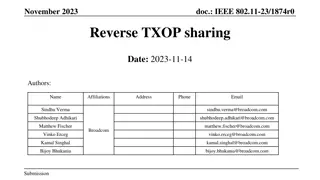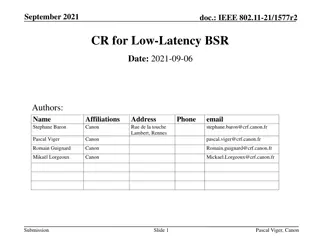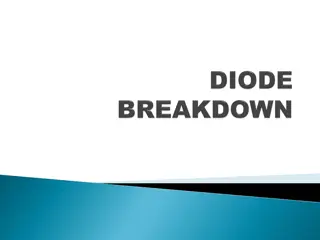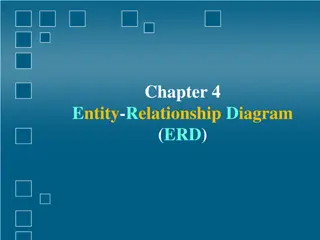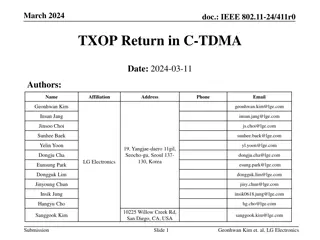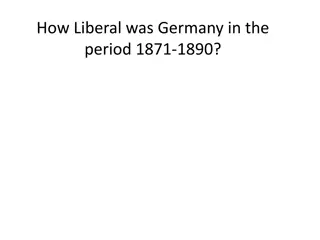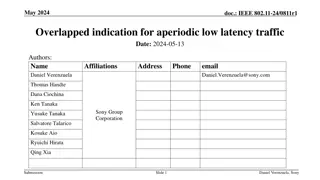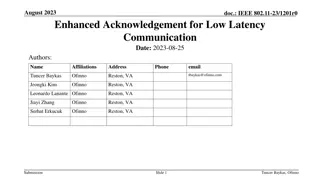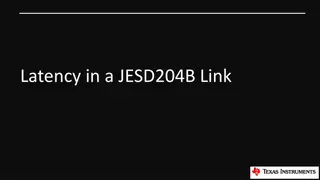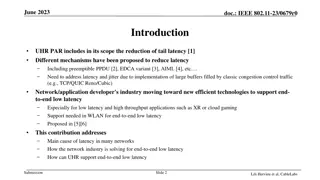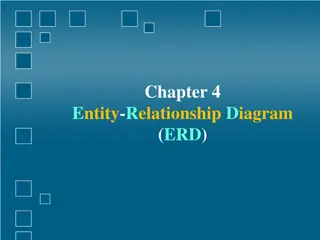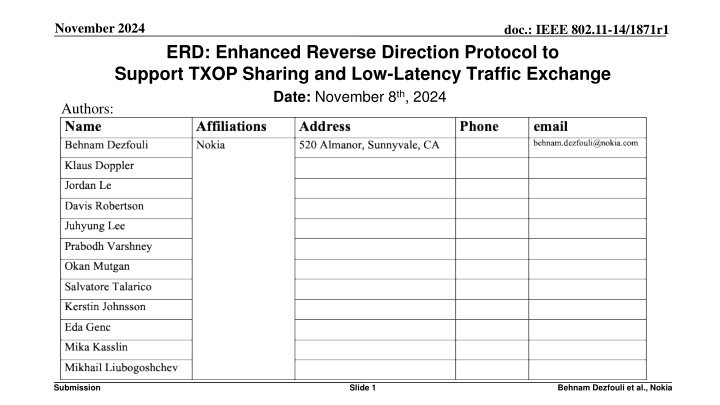
Enhanced Reverse Direction Protocol for Low-Latency Traffic Exchange in IEEE 802.11
Explore the proposed enhancements to the Reverse Direction (RD) protocol to address shortcomings in current methods of TXOP sharing and low-latency traffic exchange in IEEE 802.11 networks. Learn about using RD for interactive and Low-Latency (LL) traffic exchanges, RD protocol specifications, and bidirectional frame exchange during TXOPs. Dive deeper into the challenges and solutions presented in this November 2024 document.
Download Presentation

Please find below an Image/Link to download the presentation.
The content on the website is provided AS IS for your information and personal use only. It may not be sold, licensed, or shared on other websites without obtaining consent from the author. If you encounter any issues during the download, it is possible that the publisher has removed the file from their server.
You are allowed to download the files provided on this website for personal or commercial use, subject to the condition that they are used lawfully. All files are the property of their respective owners.
The content on the website is provided AS IS for your information and personal use only. It may not be sold, licensed, or shared on other websites without obtaining consent from the author.
E N D
Presentation Transcript
November 2024 doc.: IEEE 802.11-14/1871r1 ERD: Enhanced Reverse Direction Protocol to Support TXOP Sharing and Low-Latency Traffic Exchange Date: November 8th, 2024 Authors: Submission Slide 1 Behnam Dezfouli et al., Nokia
November 2024 doc.: IEEE 802.11-14/1871r1 Problem Statement If AP is the TXOP holder It can send DL traffic to one or more STAs during its acquired TXOP To send UL traffic, a non-AP STA can use BSR to request resources 802.11ax uses Trigger-based resource allocations to enable non-AP STAs to send UL traffic 802.11be TXS Mode 1 enables non-AP STA to send SU UL 802.11be TXS Mode 2 enables non-AP STA to perform Peer-to-Peer (P2P) transmissions with other non-AP STAs Shortcomings: (1) These sharing methods require sending control frames, and (2) if a non-AP STA needs to send peer-to-peer traffic, it cannot request for resources from the AP (e.g., when relaying operation is required) If a non-AP STA is the TXOP holder Solutions have been proposed to share TXOP with AP using control frames Shortcomings: (1) These sharing methods require sending control frames, and (2) the current proposals do not allow the AP to request TXOP sharing from non-AP STAs In this contribution, we propose enhancements to the Reverse Direction (RD) protocol to address the above shortcomings Submission Slide 2 Behnam Dezfouli et al., Nokia
November 2024 doc.: IEEE 802.11-14/1871r1 Related Contributions The Reverse Direction (RD) protocol is specified in Section 10.29 of 802.11-2020 standard Some contributions show the effectiveness of using RD for interactive and Low-Latency (LL) traffic exchanges [11-23/1387r0] [11-23/1874r0] [11-24/0668r1] (please see Appendix A) The RD protocol utilizes two bits 1. Reverse Direction Grant (RDG)/More PPDU 2. AC Constraint Both fields are located in the Command and Status (CAS) subfield, which is in the A-control subfield Submission Slide 3 Behnam Dezfouli et al., Nokia
November 2024 doc.: IEEE 802.11-14/1871r1 Overview of the existing Reverse Direction (RD) Protocol (Section 10.29 of 802.11-2020 standard) The Reverse Direction (RD) protocol allows for bidirectional frame exchange during TXOPs The TXOP Holder exchanges bidirectional traffic with the TXOP Responder TXOP Duration RDG/More PPDU = 0 RDG/More PPDU = 0 AC Constraint = 0 RDG/More PPDU = 1 RDG/More PPDU = 0 AC Constraint = 1 AC_VO AC_VO PPDU PPDU PPDU BA Non-AP STA: TXOP Holder RDG/More PPDU = 1 RDG/More PPDU = 0 RDG/More PPDU = 1 AC_VO AC_VO PPDU PPDU BA BA BA AP: TXOP Responder One burst of PPDUs from TXOP Responder (no ACK between these PPDUs) Submission Slide 4 Behnam Dezfouli et al., Nokia
November 2024 doc.: IEEE 802.11-14/1871r1 Shortcomings of RD RD does not allow the Responder to request for TXOP sharing If the Responder has LL traffic, it cannot notify the Holder RD does not allow the Responder to communicate with any STA other than the Holder LL traffic from Responder to other STAs (not the Holder) cannot be sent RD is unable to specify the TXOP sharing duration There is no guarantee on the return time of shared TXOP; the Responder may use the entire remaining TXOP duration RD is unable to specify the permissible traffic types that can be sent during a shared TXOP Simply relying on the Access Category (AC) of the last PPDU may prevent the transmission of LL traffic Further enhancement of throughput and reduction of tail latency can be achieved by overcoming the above shortcomings Submission Slide 5 Behnam Dezfouli et al., Nokia
November 2024 doc.: IEEE 802.11-14/1871r1 TXOP Holder switches to sending AC_VO frames (higher-priority traffic) TXOP Holder offers TXOP sharing to the TXOP Responder, where the permissible traffic type is AC_VO Last AC_VI frame sent by the TXOP Holder RDG/More PPDU = 1 RDG/More PPDU = 0 RDG/More PPDU = 0 AC Constraint = 0 RDG/More PPDU = 0 AC Constraint = 0 AC Constraint = 1 AC Constraint = 0 AC_VO AC_VO AC_VI AC_VI PPDU PPDU PPDU PPDU TXOP Holder RDG/More PPDU = 0 RDG/More PPDU = 0 AC Constraint = 0 AC Constraint = 0 BA BA TXOP Responder TXOP Responder declines the offer because it only has high-priority AC_VI traffic to send Submission Slide 6 Behnam Dezfouli et al., Nokia
November 2024 doc.: IEEE 802.11-14/1871r1 Enhanced Reverse Direction (ERD) We propose using an extended encoding of these two bits to support additional operational modes A TXOP Responder (AP or non-AP) can request for TXOP sharing A TXOP Responder (AP or non-AP) can request for TXOP sharing to communicate with 3rd party STAs (i.e., STAs other than the TXOP Holder) ERD does not require exchanging control frames to enable these additional operational modes In addition to the proposed encoding, the reserved bits in the CAS subfield and the remaining bits in the A-Control subfield can be leveraged to enhance RD and convey additional information such as the following: TXOP Holder can announce the permissible traffic types during the shared TXOP TXOP Responder can convey the type and amount of traffic in buffer TXOP Holder can enforce the duration of the shared TXOP duration TXOP Responder can request for a certain/minimum TXOP sharing duration Submission Slide 7 Behnam Dezfouli et al., Nokia
November 2024 Items marked with * are the newly proposed features doc.: IEEE 802.11-14/1871r1 RDG/More PPDU AC Frames sent by TXOP Holder Unused bits in CAS and A-Control subfields Constraint None 0 0 *TXOP Sharing Offer (TSO): Sharing for communication with 3rd party STAs *0 *1 Additional information TBD (see Appendix C) TXOP Sharing Offer (TSO): Sharing without AC constraint 1 0 TXOP Sharing Offer (TSO): Sharing with AC constraint 1 1 RDG/More PPDU AC Frames sent by TXOP Responder Unused bits in CAS and A-Control subfields Constraint None/Offer Rejection 0 0 *Requesting sharing for communication with 3rd party STAs (communication with the TXOP Holder is allowed) *0 *1 Additional information TBD (see Appendix C) Accepting TXOP sharing offer 1 0 *Requesting sharing for communication with the TXOP Holder *1 *1 Submission Slide 8 Behnam Dezfouli et al., Nokia
November 2024 doc.: IEEE 802.11-14/1871r1 TXOP Duration TXOP sharing offer for communication with 3rd party STAs (STAs other than the TXOP Holder) and/or the TXOP Holder RDG/More PPDU = 0 RDG/More PPDU = 0 AC Constraint = 0 AC Constraint = 1 PPDU PPDU PPDU TXOP Holder (non-AP STA) TXOP Sharing Duration RDG/More PPDU = 0 RDG/More PPDU = 1 RDG/More PPDU = 0 AC Constraint = 1 AC Constraint = 0 AC Constraint = 0 PPDU BA BA The AP may communicate with 3rd party STAs and/or the TXOP Holder Responder TXOP (AP) Accepting offer A TXOP sharing request for communication with 3rd party STAs 3rd Party STA Submission Slide 9 Behnam Dezfouli et al., Nokia
November 2024 doc.: IEEE 802.11-14/1871r1 TXOP Duration TXOP sharing offer for peer-to-peer communication RDG/More PPDU = 0 RDG/More PPDU = 0 AC Constraint = 0 AC Constraint = 1 PPDU PPDU PPDU TXOP Holder TXOP Sharing Duration (AP) RDG/More PPDU = 0 RDG/More PPDU = 1 RDG/More PPDU = 0 AC Constraint = 1 AC Constraint = 0 AC Constraint = 0 PPDU BA BA TXOP Responder (non-AP STA) The non-AP STA performs peer- to-peer communication Accepting offer P2P communication 3rd Party STA Make a TXOP sharing request Indicate its peer-to-peer traffic type/size Indicate the requested sharing duration Submission Slide 10 Behnam Dezfouli et al., Nokia
November 2024 doc.: IEEE 802.11-14/1871r1 Summary The RD protocol is an efficient way to allow a TXOP holder to share its TXOP with the TXOP responder Using RD, no control frames are required to perform sharing (i.e., minimal overhead of TXOP sharing) This contribution proposed enhancements to the RD protocol: A TXOP Responder (AP or non-AP STA) can request TXOP sharing from the Holder A TXOP Responder can request for TXOP sharing to perform communication with a 3rd party STA TXOP Holder and Responder can negotiate via exchanging information such as the TXOP sharing duration and traffic types that are allowed/need to be exchanged None of these negotiations require the exchange of additional control frames Submission Slide 11 Behnam Dezfouli et al., Nokia
November 2024 doc.: IEEE 802.11-14/1871r1 Straw Polls Do you agree that 11bn should enhance the RD protocol to allow non-AP STAs to share their TXOPs with the associated AP? YES/NO/ABSTAIN Do you agree that the 11bn standard should enhance the RD protocol to enable a non-AP STA to request a portion of its associated AP's TXOP for P2P communication? YES/NO/ABSTAIN Submission Slide 12 Behnam Dezfouli et al., Nokia
November 2024 doc.: IEEE 802.11-14/1871r1 APPENDIX A Related Contributions and Straw Polls Submission Slide 13 Behnam Dezfouli et al., Nokia
November 2024 doc.: IEEE 802.11-14/1871r1 Related Contributions The benefits of enabling non-AP STAs to share their TXOP with the AP have been demonstrated in various works and several solutions have been proposed [11-24/1224r2] [11-24/068r0] [11-23/1886r3] [11-24/0168r0] [11- 24/0389r0] [11-23/581r0] Some of these works, however, only allow a non-AP STA to share the unused portion of its TXOP with the AP [11-23/1874r0] [US9655136B2] ERD allows sharing any part of the TXOP at any time ERD is a fully in-band method that does not require the exchange of any additional control frames for sharing Some of these works present their contribution within the context of facilitating low-latency traffic exchange [11- 23/1886r3] [11-24/0168r0] [11-24/1207r0] [11-24/0389r0] There exist contributions related to the priority of channel access during TXOPs [11-24/1257r0] [11-24/416r1] Another category of works show how TXOP sharing can be leveraged to enhance relaying performance This is particularly useful for XR applications [11-24/0105r0] [11-24/0668r1] There exist contributions related to the negotiation process of such communication [11-23/1958r0] [11- 24/0073r0] [11-24/1885r1] ERD can also be used with SCS to inform the AP to whom the packet must be forwarded Submission Slide 14 Behnam Dezfouli et al., Nokia
November 2024 doc.: IEEE 802.11-14/1871r1 Related Straw Polls Allow non-AP STAs to share their TXOPs with the associated AP [11-24/068r0] [11-23/581r0 and 11-23/1847r0] [11-23/1387r0] [11-23/1874r0] [11-24/1224r2] [11-24/0668r1] [11-23/1886r3] [11- 24/0168r0] [11-24/1207r0] [11-24/0389r0] Do you support allowing a non-AP STA initiate downlink transmissions with its associated AP in TGbn? [11-24/1224r2] [11-24/0168r0] [11-23/1886r3] [11-24/0389r0] Do you support allowing a non-AP STA initiate downlink/uplink transmissions with its associated AP and P2P transmissions with its peer STA(s) in the same TXOP in TGbn? [11-24/1224r2] [11-24/0668r1] Do you support enhancing relaying operation for AP-STA1-STA2 communication? [11-24/0105r0] [11-24/0668r1] [11-23/1958r0] [11-24/1885r1] Submission Slide 15 Behnam Dezfouli et al., Nokia
November 2024 doc.: IEEE 802.11-14/1871r1 APPENDIX B Shortcoming of RD with Specifying Reverse Direction Traffic Submission Slide 16 Behnam Dezfouli et al., Nokia
November 2024 doc.: IEEE 802.11-14/1871r1 The existing method used by RD (Section 10.29 of 802.11-2020) for constraining the traffic types that can be sent during the shared TXOPs may impose some limitations Submission Slide 17 Behnam Dezfouli et al., Nokia
November 2024 doc.: IEEE 802.11-14/1871r1 For instance, consider the following case The TXOP Holder acquires the TXOP and sends frames belonging to AC_VI The TXOP Holder then sends its high-priority traffic belonging to AC_VO Since the AC of the PPDU is AC_VO, the AC Constraint field of the frame sent by the TXOP Holder informs the TXOP Responder that only traffic belonging to AC_VO can be sent The TXOP Responder declines the offer because its buffered traffic type is AC_VI However, the TXOP Holder wanted to allow both AC_VO and AC_VI to be sent by the TXOP Responder This is especially important when the TXOP Responder needs to reply back to the Holder with frames that belong to the same traffic stream (e.g., same TCP/UDP connection) Therefore, simply relying on the AC Constraint field sent by the TXOP Holder may not provide the specific granularity needed to control permissible traffic types during shared TXOPs An enhanced and flexible method proposed by ERD We propose a new subfield, called TXOP Sharing-Traffic Characteristics Indication(TXS-TCI) We propose to use the 5 reserved bits of CAS subfield to encode permissible traffic types An alternative approach is to use the 5 bits of CAS plus the 14 remaining bits of A-Control subfield Submission Slide 18 Behnam Dezfouli et al., Nokia
November 2024 doc.: IEEE 802.11-14/1871r1 APPENDIX C More Details about ERD Features and Operation Submission Slide 19 Behnam Dezfouli et al., Nokia
November 2024 doc.: IEEE 802.11-14/1871r1 Items marked with * are the newly introduced subfields A-Control (30 bits total) CAS (8 bits total) 4 bits 1 bit 1 bit 1 bit 5 bits (reserved) 4 bits 14 bits *TXS-TCI TXOP Holder: Permissible traffic types TXOP Responder: Buffer report *A new Control ID value (between 10 to 14) *TXS-DU TXOP Holder: TXOP sharing duration TXOP Responder: Requested TXOP sharing duration CAS Control ID value: 6 AC Constraint (*extended encoding) RDG/More PPDU (*extended encoding) PSRT PPD U TXS-TCI: TXOP Sharing-Traffic Characteristics Indication TXS-DU: TXOP Sharing-Duration For the AC Constraint and RDG/More PPDU fields, we propose extended bit encodings, in addition to those available in the existing RD protocol (in 802.11ax/be) Submission Slide 20 Behnam Dezfouli et al., Nokia
November 2024 Items marked with * are the newly proposed features doc.: IEEE 802.11-14/1871r1 RDG/More PPDU AC Frames sent by TXOP Holder *TXS-TCI *TXS-DU Constraint None *Time until next TXOP sharing *The minimum/exact amount of time before next TXOP sharing instance 0 0 *TXOP Sharing Offer (TSO): Sharing for communication with 3rd party STAs *Permissible traffic types during the TXOP sharing period *0 *1 *TXOP sharing duration TXOP Sharing Offer (TSO): Sharing without AC constraint 1 0 *TXOP sharing duration TXOP Sharing Offer (TSO): Sharing with AC constraint *Permissible traffic types during the TXOP sharing period 1 1 *TXOP sharing duration RDG/More PPDU AC Frames sent by TXOP Responder *TXS-TCI *TXS-DU Constraint None/Offer Rejection 0 0 *Offer Rejection *Requesting sharing for communication with 3rd party (communication with the TXOP Holder is allowed) *0 *1 *Traffic type/amount report *Requested TXOP sharing duration Accepting TXOP sharing offer While Responder is sending frames to the Holder 1 0 *Offer Rejection *Requesting sharing for communication with TXOP Holder *1 *1 *Traffic type/amount report *Requested TXOP sharing duration Submission Slide 21 Behnam Dezfouli et al., Nokia
November 2024 doc.: IEEE 802.11-14/1871r1 The TXOP Holder may announce in its PPDUs the minimum amount of time before the next TXOP sharing instance This time difference (next TXOP sharing current time) can be announced via the TXS-DU field TXOP Sharing Offer (TSO) frame TXS-DU = D1 Time until next TXOP sharing = I2 Time until next TXOP sharing = I1 TXOP Sharing Offer (TSO) frame TXS-DU field = D2 STAX: TXOP Holder I2 I1 D1 D2 TXOP Sharing Duration TXOP Sharing Duration STAY: TXOP Responder Sleep Sleep STAZ: 3rd Party STA Submission Slide 22 Behnam Dezfouli et al., Nokia
November 2024 doc.: IEEE 802.11-14/1871r1 TXOP Duration D1 Initial TXOP Sharing Duration D2 Updated TXOP sharing duration TXS-DUfield = D2 TXOP Sharing Offer (TSO) TXS-DU field = D1 Updated TXOP Sharing Duration Early termination of TXOP sharing period RDG/More PPDU = 1 RDG/More PPDU = 1 RDG/More PPDU = 0 RDG/More PPDU = 0 RDG/More PPDU = 0 AC Constraint = 0 AC Constraint = 0 AC Constraint = 1 AC Constraint = 0 AC Constraint = 1 TXS-DU TXS-DU AC_VI AC_VI AC_VI PPDU PPDU PPDU BA BA TXOP Holder RDG/More PPDU = 0 RDG/More PPDU = 1 RDG/More PPDU = 1 RDG/More PPDU = 0 AC Constraint = 0 AC Constraint = 0 AC Constraint = 0 AC Constraint = 0 AC_VO PPDU PPDU BA BA TXOP Responder This PPDU is ACK/BA soliciting The Responder does not return the TXOP to the Holder as long as RDG/More PPDU = 1 and AC Constraint = 0 Responder returns the TXOP to the Holder Submission Slide 23 Behnam Dezfouli et al., Nokia
November 2024 doc.: IEEE 802.11-14/1871r1 TXOP Holder offers TXOP sharing to the TXOP Responder, where the permissible traffic types are AC_VO and AC_VI The TXS-TCI field is included to convey the permissible traffic types TXOP Holder switches to sending AC_VO frames Last AC_VI frame sent by the TXOP Holder RDG/More PPDU = 1 RDG/More PPDU = 0 TXS-TCI and TXS-DU RDG/More PPDU = 0 RDG/More PPDU = 0 AC Constraint = 0 AC Constraint = 0 AC Constraint = 1 AC Constraint = 0 AC_VO AC_VO AC_VI AC_VI PPDU PPDU PPDU PPDU TXOP Sharing Duration TXOP Holder RDG/More PPDU = 1 RDG/More PPDU = 1 RDG/More PPDU = 0 AC Constraint = 0 AC Constraint = 0 AC Constraint = 0 AC_VI PPDU BA BA TXOP Responder TXOP Responder accepts the offer because it has AC_VI traffic to send Submission Slide 24 Behnam Dezfouli et al., Nokia
November 2024 doc.: IEEE 802.11-14/1871r1 Requesting for TXOP Sharing The TXOP Responder may request the Holder to share its TXOP A Responder can send a request frame to the Holder if the Holder is currently expecting to receive at least one frame (e.g., ACK/BA, data frame) from the Responder The Responder can send two types of requests: Request for sharing TXOP to communicate with the Holder Request for sharing TXOP to communicate with 3rd party STAs and potentially the Holder too When sending a TXOP sharing request, the Responder can use the proposed TXS-TCI field to indicate the type and/or the amount of its buffered data The Responder can use use the following two types of requests To request for TXOP sharing to communicate with 3rd party STAs: RDG/More PPDU = 0 and AC Constraint = 1 The TXS-DU field of this frame conveys the minimum requested duration of sharing To request for TXOP sharing to communicate with the TXOP Holder RDG/More PPDU = 1 and AC Constraint = 1 The TXS-DU field of this frame conveys the minimum requested duration of sharing Submission Slide 25 Behnam Dezfouli et al., Nokia
November 2024 doc.: IEEE 802.11-14/1871r1 Case 1: No ongoing sharing period Whenever the Holder is expecting an ACK/BA from the Responder, the Responder can use the ACK/BA frame to make the request Note: Any frame, such as BA, using the Control Wrapper can include the A-Control subfield See the next slide Note: A Responder cannot use random-access for sending such request frames; the Responder can only send such requests when allowed by the Holder Submission Slide 26 Behnam Dezfouli et al., Nokia
November 2024 doc.: IEEE 802.11-14/1871r1 TXOP Duration RDG/More PPDU = 0 RDG/More PPDU = 0 TXS-TCI and TXS-DU RDG/More PPDU = 0 TXOP sharing offer for communication with 3rd party STAs AC Constraint = 0 AC Constraint = 1 AC Constraint = 0 PPDU PPDU PPDU TXOP Sharing Duration TXOP Holder (AP) TXS-TCI and TXS-DU RDG/More PPDU = 0 RDG/More PPDU = 1 RDG/More PPDU = 0 AC Constraint = 1 AC Constraint = 0 AC Constraint = 0 PPDU BA BA TXOP Responder (non-AP STA) The STA may communicate with 3rd party STAs and the AP Accepting offer P2P communication 3rd Party STA Request for TXOP sharing for communication with 3rd party STAs Uses TXS-TCI to indicate its traffic type/size Used TXS-DU to indicate its requested sharing duration Submission Slide 27 Behnam Dezfouli et al., Nokia
November 2024 doc.: IEEE 802.11-14/1871r1 Case 2: An ongoing sharing period where: The TXOP has already been shared with the TXOP Responder to communicate with the Holder, and The Responder needs to communicate with 3rd party STAs The Responder must use combination RDG/More PPDU = 1 and AC Constraint = 0 in all of its frames, except the last one Therefore, to request a new type of sharing, the Responder needs to end the current sharing while also making a new request This can be achieved by using either of the frame types used for requesting TXOP Sharing See next slide Submission Slide 28 Behnam Dezfouli et al., Nokia
November 2024 doc.: IEEE 802.11-14/1871r1 TXOP Duration TXOP sharing offer for communication with 3rd party STAs TXOP sharing offer for communication with TXOP Holder RDG/More PPDU = 1 TXS-TCI and TXS-DU TXS-TCI and TXS-DU RDG/More PPDU = 0 AC Constraint = 1 AC Constraint = 1 PPDU BA TXOP Sharing Duration TXOP Sharing Duration TXOP Holder (AP) RDG/More PPDU = 1 RDG/More PPDU = 0 TXS-TCI and TXS-DU RDG/More PPDU = 1 RDG/More PPDU = 1 RDG/More PPDU = 0 AC Constraint = 0 AC Constraint = 0 AC Constraint = 1 AC Constraint = 0 AC Constraint = 0 PPDU (e.g., NDP) PPDU (e.g., NDP) PPDU PPDU BA TXOP Responder (non-AP STA) The STA may communicate with 3rd party STAs and the AP P2P communication 3rd Party STA Request for TXOP sharing for communication with 3rd party STAs Uses TXS-TCI to indicate its traffic type/size Used TXS-DU to indicate its requested sharing duration Submission Slide 29 Behnam Dezfouli et al., Nokia
November 2024 doc.: IEEE 802.11-14/1871r1 Case 3 (not required): The TXOP has already been shared with the TXOP Responder to communicate 3rd party STAs The Responder needs to communicate with the Holder The Responder is allowed to communicate with the Holder Therefore, this case does not require any additional request for sharing Submission Slide 30 Behnam Dezfouli et al., Nokia
November 2024 doc.: IEEE 802.11-14/1871r1 When a Responder receives an offer, if the offer does not align with its needs, it can send another request using the same frame that is used to decline the previous offer The counteroffer may be sent via BA or other types of PPDUs Submission Slide 31 Behnam Dezfouli et al., Nokia
November 2024 doc.: IEEE 802.11-14/1871r1 TXOP Duration RDG/More PPDU = 0 RDG/More PPDU = 0 TXS-TCI and TXS-DU TXS-TCI and TXS-DU RDG/More PPDU = 0 AC Constraint = 0 AC Constraint = 1 AC Constraint = 1 PPDU PPDU PPDU TXOP Sharing Duration TXOP Holder (AP) TXS-TCI and TXS-DU RDAC Constraint = 1 RDG/More PPDU = 0 RDG/More PPDU = 0 AC Constraint = 1 AC Constraint = 0 G/More PPDU = 0 PPDU BA BA TXOP Responder (non-AP STA) The STA may communicate with 3rd party STAs and the AP Accepting offer P2P communication 3rd Party STA Decline the offer and make a new request Uses TXS-TCI to indicate its traffic type/size Used TXS-DU to indicate its requested sharing duration Submission Slide 32 Behnam Dezfouli et al., Nokia
November 2024 doc.: IEEE 802.11-14/1871r1 APPENDIX D RD Encoding within the HT Control Field Reference: 802.11 - 2020 standard Submission Slide 33 Behnam Dezfouli et al., Nokia
November 2024 doc.: IEEE 802.11-14/1871r1 RD Encoding within the HT Control Field Submission Slide 34 Behnam Dezfouli et al., Nokia
November 2024 doc.: IEEE 802.11-14/1871r1 RD Encoding within the HT Control Field Submission Slide 35 Behnam Dezfouli et al., Nokia


